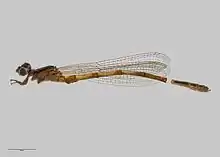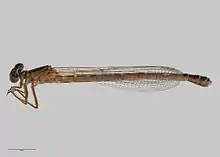Xanthocnemis zealandica
Xanthocnemis zealandica, commonly known as common redcoat damselfly,[1] red damselfly, or red coat damselfly, is the most common native New Zealand damselfly.[2] Adult damselflies are often seen flying around vegetation close to streams.
| Xanthocnemis zealandica | |
|---|---|
 | |
| Male holotype specimen held at the Auckland War Memorial Museum. | |
 | |
| Female allotype specimen held at the Auckland War Memorial Museum. | |
| Scientific classification | |
| Domain: | Eukaryota |
| Kingdom: | Animalia |
| Phylum: | Arthropoda |
| Class: | Insecta |
| Order: | Odonata |
| Suborder: | Zygoptera |
| Family: | Coenagrionidae |
| Genus: | Xanthocnemis |
| Species: | X. zealandica |
| Binomial name | |
| Xanthocnemis zealandica (McLachlan, 1873) | |
X. zealandica has a 2–3 year life cycle; the shorter one was observed near sea level while the longer one was characteristic to a mid-elevation site (579 m (1,900 ft) above sea level). Some individuals at the lowland site may even complete their life cycle in one year.[3] X. zealandica larvae are widespread across New Zealand, occurring in rocky and weedy streams and ponds.[4] It is predominantly a low-altitude species but can reach 1,945 m (6,381 ft) above sea level.[1] The larvae of the red damselfly are identified by their pointed tail gills and long hairs by the tip.[4]
References
- Rowe, R. (2020). "Xanthocnemis zealandica". IUCN Red List of Threatened Species. 2020: e.T197094A83372380. doi:10.2305/IUCN.UK.2020-1.RLTS.T197094A83372380.en. Retrieved 4 October 2021.
- "Damselfly (Red)(Xanthocnemis zealandica)". Taranaki Educational Resource: Research, Analysis and Information Network. Retrieved 2012-04-25.
- Deacon, K.J. (1979). The Seasonality of four Odonata species from mid Canterbury, South Island, New Zealand (PDF) (Ph.D. thesis). Canterbury University.
- "Red damselfly (Coenagrionidae: Xanthocnemis)". Landcare Research. Retrieved 2012-04-26.
